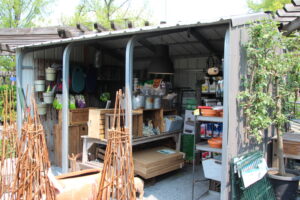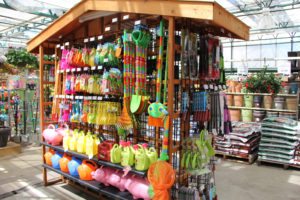Preparing for Hibernation
When it comes to the off-season, the one thing many retailers dread is storage. In a perfect world, you would sell off all your merchandise by the fall and have no need to store anything. Unfortunately, that is a rarity for most retailers. In the next couple months, you may need to discount items to get them off the shelves or even start hauling away unsold merchandise. It’s not something you’re looking forward to, but it is necessary to make room for winter products and to salvage those items that may become damaged in the cold weather.
Utilizing Storage Space
Whether you have an off-site storage facility or a storage shed outside your garden center or even just shelving on the walls where you keep merchandise, you must come up with some kind of system that allows you to utilize all the space you have.
Using an off-site storage facility has both positive and negative aspects, as Teri Smith of Smith’s Acres in Niantic, Conn., can confirm. They use a barn on an off-site farm location, and the main reason the off-site storage works is because it frees up space at the garden center and enables Smith to use more space for items for sale.
On the other hand, packing all the merchandise, loading it up and sending it off to the off-site location can be quite a hassle. “It seems like whenever I send stuff back, it’s always a bad time,” Smith shares. “No one at the farm has time to properly store everything all in one stop. It’s just a whole back-and-forth thing.”
And sometimes, you just have to use any empty space within your garden center that you can find. It may not be the most organized strategy, but storing items inside your garden center may be your only option. “We try to utilize all the space we’ve got,” says Smith. “I’ve got a shelf unit in the bathroom. I’ve got shelves on the wall over the desks. I have cubby holes for tools and gloves hidden in another spot.”
Just keep in mind that if you’re storing items this way, you will want to clearly label everything and keep inventory of where everything is stored. Otherwise, next season, you may not be able to find the stored merchandise.
Handling Pottery
Packing and unpacking merchandise may lead to damaged items. Pottery is often the one item you will have the most left over at the end of the season, and it can take up a lot of space. Your first instinct may be to pack it up and store it, especially since you won’t be selling much pottery during the winter. But this strategy is risky, as pottery can easily break during the moving process.
Gary Pahl of Pahl’s Market in Apple Valley, Minn., suggests simply keeping pottery and other cement products outdoors. “We just group them up and flip them upside-down,” Pahl says. “By the time you repack it and put it in a shed, you break too many pieces.” Plus, repackaging pottery can become costly and may not be worth the hassle.
Save Your Plants
Ideally, you will have sold all your green goods by the end of the season, but that isn’t always the case. So what can you do to salvage the leftover plants? Rather than marking them down and trying to get rid of them, you can save them by putting them in a greenhouse over the winter.
Starting in early November, Walter Morrison of Morrison’s Home & Garden in Plymouth, Mass., begins putting plants such as broadleaf evergreens, some perennials and Japanese maples into a double-layer poly greenhouse. “The outside layer is white poly so the house won’t heat up in the winter,” he shares. They put all the other deciduous stock, pot to pot, in a corner of their yard out of the wind, and then put wood chips around the entire group of pots. Additional perennials are cut back and put under a foam blanket for the winter, Morrison adds.
Rethink Ordering Structure
When it comes to storage, you may end up re-handling product too many times. Labels get soiled, products get ruined, boxes get misplaced, etc. One way to deal with this problem is to order less product more frequently. And along the way, use sales to move more product out the door.
At the end of last season, Smith took a look at her ordering structure. “I did a quick inventory, which gave me an idea of what was available for sale and how much I had left over,” she says. She learned that she was purchasing too much product, especially live goods.
“Don’t buy 50 annuals,” she advises, “because in a month you only really need maybe 20. So buy 20 at a time… it doesn’t make sense to buy extra.” She now buys in smaller quantities and is able to turn it over more often. Pottery was another item she began buying in smaller quantities. Just last year, she had 11 pallets of pottery sitting in the parking lot before the garden center opened up for the spring.
Controlling your inventory may not be the easiest thing, but it is a huge help in the long run. You won’t be forced to mark down items at the end of the season, and you won’t have to worry about storing away as much left over merchandise.


















 Videos
Videos





